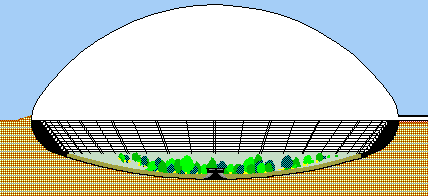
| |
 |
In past cataclysms, faced with high winds and hailstones, many sought shelter in caves or caverns. This as often brought death as salvation, as these hollow places were formed during mountain building in the past, so seeking shelter in them is equivalent to trying to avoid traffic by standing in the middle of a busy highway. Subterranean cavities that are safe are not open to the surface, which in and of itself indicate frailty in the surrounding rock strata. Subterranean cavities that would be safe are so deep and thickly surrounded by rock that they are essentially a bubble in a slab of granite. Underground structures, such as the one constructed by the government at Mount Weather, are insufficient to withstand the violent compression that will occur during 15 Richter point earthquakes.
Note: inset written during the Dec 28, 2002 Live ZetaTalk IRC Session.
Mankind visits caves, which show their age in the slow accumulation of drip-fed rock, and think underground caverns safe. At the same time, man-made mines collapse or fill with water, with horror stories of miners buried alive. There are caves in rock that last eons, and mines that man made that likewise hold up, but compared to the risks of aboveground shelters during the shift, they are high risk. Mankind has little experience with Richter 9 force quakes, with only projection on what the Richter on famous quakes such as the 1906 San Francisco quake were. Dramatic rock shattering, such as was required to drive raw rock at a slant, skyward, during prior shifts, is not in the memory of man. Caverns available then, for man to crawl into, which closed and trapped whatever crawled there, are lost to man. On occasion, he digs bones frozen in what was formerly mud, a volcanic flow or river bed. How the animals died is conjecture. If human bones are found in caverns, it is assumed they died of disease, not entrapment.
If the force of a shift, in the recent past, has driven mountains over the plains in the US West, rumpled the foothills of the Sierras, heaved the Himalayas higher, and melted rock with subduction, then why line of thinking allows this rock to remain firm and undisturbed just because it is the wall of a cavern? It is not immune from what is happening during mountain building, during the shift: shattering rock, rapid sideways motions, flaking and separating, and snapping. In heartland’s, where mountain building may not be occurring, there are rocks and caves which are assumed not to be affected. But stretching, growing rifts, can likewise create collapse. Thus, to avoid being buried alive, crushed, do not be underground during the shift. Allow yourself access to the open air.
Cities will not be safe. During these coming times, most of the cities, most of your existing structures, will crumble, even if they are retrofitted. The types of quakes
and shocks will be unexpected, and will find the weak link in the way these building have been constructed. Beyond collapsing buildings that will be virtual death
traps, gas lines and oil and gasoline storage will be in flames, and the whole place likely to become an inferno. A building awry, cracking, tipping, ready to crumble,
is not a safe place to live in and they will be abandoned, and eventually will crumble due to the weather. During violent earthquakes, those humans who survived
were surrounded by the least structure. Those who live in light housing will find that they survive, not crushed by their dwelling, but will be temporarily without
housing. Where the weather is temperate, this can be dealt with. Temporary structures can be built from trash, dug into the hillside, and bermed structures are
warm, insulated by the Earth. Those who survive and are resourceful will find that they may not be living with the standard of living that they had before, but they
are snug.
So, if one cannot huddle in buildings or caves and the winds are of hurricane force, what to do? Valleys between sheltering hills protect from winds to some degree,
but give no shelter from firestorms or hailstones. In looking at stable structures like shipping containers, well braced and ready to handle a great deal of weight, of
course they will resist as long as they don't have a rock slide or something like that attacking their structure, and as long as the container is well secured so that the
occupants don't get tossed around or rolled in high winds or a rumbling rolling earth. There will be a great many aftershocks as well as the major shocks of the pole
shift, times when the plates of the Earth are going to be settling for some time.
The single structure that resists tearing away in hurricane force winds and can withstand the magnitude of earthquakes expected is a continuous oval, partly laid into
the earth. Domed Structures give the least resistance to winds, and where the dome is continuous, provides a shape most resistance to earthquake damage. Wind
sweeps over but does not lift this, and the sharp jolt of an earthquake will not crack a continuous form. An oval with a bit of a plate shape on the bottom will also
settle into its pre-quake position under the jiggling influence of after shocks, readjusting itself on lose earth after a quake such that one does not find the house at a
tilt for long. Made of Metal, such a structure also protects from fire and hailstones. It may be a radical theory, but an oval of this nature can make a nice ceiling, a
pleasant place to be indoors when indoor living and indoor gardening is going to be a necessity. Many Service-to-Other groups are working on such structures, in
preparation for the coming cataclysms.
